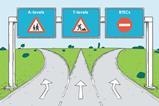Some schools are opting for fewer but longer lessons. Find out what’s involved and if it’s working

Here’s a question: if, as we’re often told, concentration spans are shrinking, why are some schools opting to increase lesson time? Bottisham Village College in Cambridgeshire is one school that’s made the change. It switched from 60 to 100-minute classes last September. The rationale wasn’t just about lessons, but the whole school day, including the impact of 1500 students on the move and the resulting lost learning time.
Helen Slipper, head of science, says the school also wanted to reduce the cognitive load of five lessons a day and provide opportunities to delve more deeply into a topic. Giving students time to collaborate and see each other’s perspective was another key consideration.
‘In a 60-minute lesson, you’re determined to make sure students learn what they should from a practical, and sometimes we shy away from spending too long on giving them opportunities to make suggestions, to hypothesise, to draw conclusions. The longer lesson gives them a little bit more scope to try and start to think more for themselves,’ she says.
Great for practicals
Lucy, a chemistry teacher at a London secondary school, can also see some advantages. ‘It’s brilliant for practicals,’ she realised, after finishing a ‘whole curriculum day’, working with students in preparation for GCSEs this summer.
‘You can really set up the practical: start from the beginning talking about the hypothesis, the variables and what you’re going to control, and get the students to think about how they would do the experiment and write a method before they even begin. When you only have an hour, you often have to do all those things in the lesson before. By the time you get to the practical, they’ve semi-forgotten it. Longer lessons also give you time to draw graphs at the end, analyse the data and discuss your conclusions. However, I wouldn’t want to be doing very long lessons for years 7 and 8.’
Teachers are using it as an opportunity to refresh their practice
She’s also less certain of the benefits in a lesson without a practical. ‘There’s a module in the syllabus that we do on bonding. Obviously, you could get pupils to make models and so on, but then it’s the question of whether you have time to get through everything.’
Longer lessons take a lot of planning too. Helen’s school researched the importance of recall and ‘little and often’ approaches. It isn’t good enough to just stretch out the typical phases of a 60-minute lesson because that impacts students’ concentration.
‘You have shorter cycles of those processes – how you bring in a demonstration, how you bring in opportunities for practical work, so you have more parts to a lesson,’ Helen explains. ‘And it’s about moving them between each of those things to adjust their focus and maintain concentration, perhaps using a mini whiteboard to check understanding more often in a lesson (and before moving on). This is really powerful in breaking a student’s chain of thought, so they don’t feel it’s continually on the same track.’
How do younger students cope?
It’s important for teachers to get to know their students well, says Helen, and then to plan the phases and pacing to suit different classes – adjusting within a lesson if needs be.
Feedback from students is that they want to get up and do something in each lesson. That’s easy to achieve with science practicals, but more of a challenge in other subjects. Helen says teachers are thinking hard about transitions within lessons and using it as an opportunity to refresh their teaching practice.
Build stronger relationships with pupils
What about the frequency of individual science lessons, Lucy asks, which may not matter as much in the lower year groups, as these are topic based. In her school, specialists teach different classes by year 9 – an easier split to make for the more frequent 60-minute lessons than 100 minutes.
‘We’re still covering the course in the same amount of time,’ responds Helen. ‘But we’re finding that we don’t feel rushed in what we’re doing with the students.’
Building teacher–pupil bonds
The hope is that longer classes will give teachers a better chance to build stronger relationships with pupils, but how does little and often square with having longer gaps between subject lessons? ‘We’ve worked hard on our homework – connecting lessons together,’ says Helen. ‘Students get a small piece focused on retrieval and consolidation every session, so they’re doing the linking work between those lessons.’
There’s a dynamic to think about, adds Lucy. ‘When you go to a new lesson or class … even as a teacher, with a new class, with a new topic … there is an energy there.’ She believes that most teachers might want to mix it up a bit with lesson length, for example, if there’s a difficult child. ‘Imagine the behaviour management if it’s not a school where the students are well behaved,’ she says.
Her school has five minutes between classes, ‘so all the kids move around from one place to another. OK, it’s a waste of time but they’re getting some exercise, so I think it’s probably a good waste of time.’
Meanwhile at Bottisham, staff and students are still getting used to a new system. ‘We’re continually learning,’ says Helen.














No comments yet